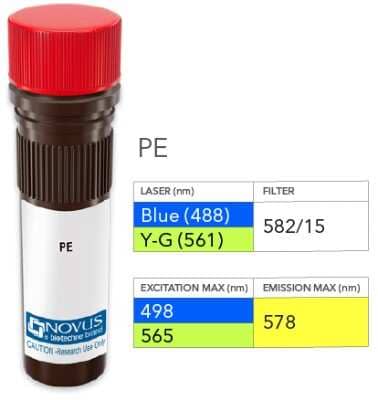L-Selectin/CD62L Antibody (DREG56) [PE]
Novus Biologicals, part of Bio-Techne | Catalog # NBP1-42795PE
Clone DREG56 was used by HLDA to establish CD designation.


Conjugate
Catalog #
Forumulation
Catalog #
Key Product Details
Species Reactivity
Human
Applications
CyTOF-ready, Flow Cytometry, Immunohistochemistry, Immunohistochemistry-Frozen, Immunoprecipitation, Western Blot
Label
PE (Excitation = 488 nm, Emission = 575 nm)
Antibody Source
Monoclonal Mouse IgG1 Clone # DREG56
Concentration
Please see the vial label for concentration. If unlisted please contact technical services.
Product Specifications
Immunogen
PMA-activated human peripheral blood leukocytes
Specificity
The mouse monoclonal antibody DREG56 recognizes CD62L / L-selectin, a 65-76 kDa cell surface protein, expressed by neutrophils, monocytes, and subsets of T, B, and NK cells, that interacts with specific carbohydrates exposed on activated endothelial cells. HLDA V; WS Code S056
Clonality
Monoclonal
Host
Mouse
Isotype
IgG1
Scientific Data Images for L-Selectin/CD62L Antibody (DREG56) [PE]
Product Image: L-Selectin/CD62L Antibody (DREG56) [PE] [NBP1-42795PE] - Vial of PE conjugated antibody. PE has two excitation maxima, 498 nm excited by the Blue laser (488 nm) and 565 nm excited by the Yellow-Green laser (561 nm). Both result in emission at 578 nm.
Applications for L-Selectin/CD62L Antibody (DREG56) [PE]
Application
Recommended Usage
CyTOF-ready
Optimal dilutions of this antibody should be experimentally determined.
Flow Cytometry
Optimal dilutions of this antibody should be experimentally determined.
Immunohistochemistry
Optimal dilutions of this antibody should be experimentally determined.
Immunohistochemistry-Frozen
Optimal dilutions of this antibody should be experimentally determined.
Immunoprecipitation
Optimal dilutions of this antibody should be experimentally determined.
Western Blot
Optimal dilutions of this antibody should be experimentally determined.
Formulation, Preparation, and Storage
Purification
Protein A purified
Formulation
PBS
Preservative
0.05% Sodium Azide
Concentration
Please see the vial label for concentration. If unlisted please contact technical services.
Shipping
The product is shipped with polar packs. Upon receipt, store it immediately at the temperature recommended below.
Stability & Storage
Store at 4C in the dark.
Background: L-Selectin/CD62L
L-selectin expressed on leukocytes binds to ligands expressed by endothelial cells where it plays a role in lymphocyte homing to secondary lymphoid organs (2-5). L-selectin specifically recognizes and binds to sulfated sialyl-Lewis epitopes of O-linked glycans (2-4). Ligands for L-selectin include glycosylation-dependent cell adhesion molecule-1 (GlyCAM-1), CD34, mucosal vascular addressin cell adhesion molecule-1 (MAdCAM-1), and P-selectin glycoprotein ligand-1 (PSGL-1) (2,4). Elevated levels of selectin ligands on tumor cells are associated with cancer progression and metastasis (3). High levels of L-selectin and soluble L-selectin (sL-selectin) has been implicated in a number of pathologies from viral infection and allergies, to sepsis and multiple sclerosis (2,4,5). For example, L-selectin has been shown to play a role in human immunodeficiency virus (HIV) infection. HIV envelope glycans, such as gp120, binds to L-selectin/CD62L on CD4+ T cells, facilitating viral adhesion (2,5). A disintegrin and metalloproteinase (ADAM)17 is the primary enzyme responsible for L-selectin shedding in leukocytes, which is triggered in response to inflammatory signals (1,2,5). AMAD17 inhibitors block L-selectin shedding and reduce viral release (2,5). Given their role in cancer and other diseases, selectins and their ligands are potential targets for therapeutic intervention (3,5). For instance, murine models have shown that anti-L-selectin antibodies can delay onset of graft versus host disease (5).
References
1. Ivetic A. (2018). A head-to-tail view of L-selectin and its impact on neutrophil behaviour. Cell and Tissue Research, 371(3), 437-453. https://doi.org/10.1007/s00441-017-2774-x
2. Ivetic, A., Hoskins Green, H. L., & Hart, S. J. (2019). L-selectin: a major regulator of leukocyte adhesion, migration and signaling. Frontiers in Immunology, 10, 1068. https://doi.org/10.3389/fimmu.2019.01068
3. Borsig L. (2018). Selectins in cancer immunity. Glycobiology, 28(9), 648-655. https://doi.org/10.1093/glycob/cwx105
4. Kneuer, C., Ehrhardt, C., Radomski, M. W., & Bakowsky, U. (2006). Selectins-potential pharmacological targets?. Drug Discovery Today, 11(21-22), 1034-1040. https://doi.org/10.1016/j.drudis.2006.09.004
5. Segura, J., He, B., Ireland, J., Zou, Z., Shen, T., Roth, G., & Sun, P. D. (2021). The role of L-Selectin in HIV infection. Frontiers in Microbiology, 12, 725741. https://doi.org/10.3389/fmicb.2021.725741
Alternate Names
CD62L, hLHRc, LAM1, LECAM1, Leu-8, LNHR, LSEL, Lyam-1, LYAM1, PLNHR, SELL, TQ1
Gene Symbol
SELL
Additional L-Selectin/CD62L Products
Product Documents for L-Selectin/CD62L Antibody (DREG56) [PE]
Product Specific Notices for L-Selectin/CD62L Antibody (DREG56) [PE]
This product is for research use only and is not approved for use in humans or in clinical diagnosis. Primary Antibodies are guaranteed for 1 year from date of receipt.
